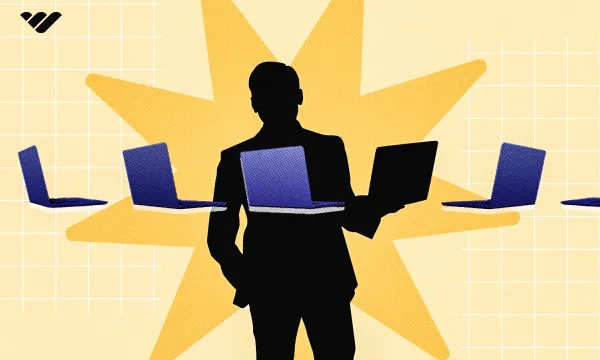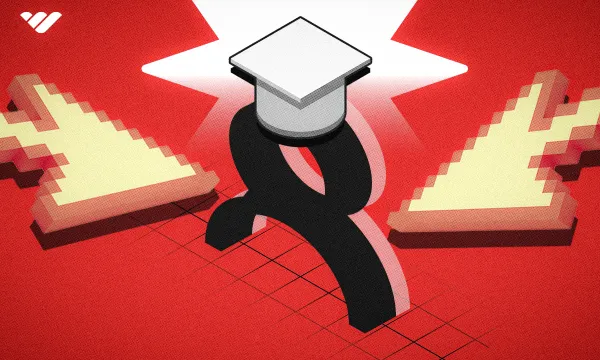Having more money is hardly ever a problem—the problem is knowing how to get it. Picking up a second and a third job is a surefire way to burnout, and your life shouldn't have to revolve around work, right?
That's where money-making apps come in handy. You're your own boss, but the money still comes flowing in.
There are lots of apps out there that will promise you great earnings, but which ones are legit?
How to Make Money Online With Apps
You can make money online with apps in many different ways, including surveys, playing games, investing, or creating your own digital products. Making money on your phone has never been easier than it is now, with some apps letting you earn a bit of pocket money every month and others replacing a full-time job.
Below, we'll dive into a wide range of apps that can supplement your income or replace it entirely. Here are 21 apps that are worth trying if you want to make money on your phone.
21 of the Best Money-Making Apps
Whether you want an app that lets you make money from the comfort of your own home or one that connects you with people who need something in your area, there are lots of options to consider. Let's get started.
1. Whop
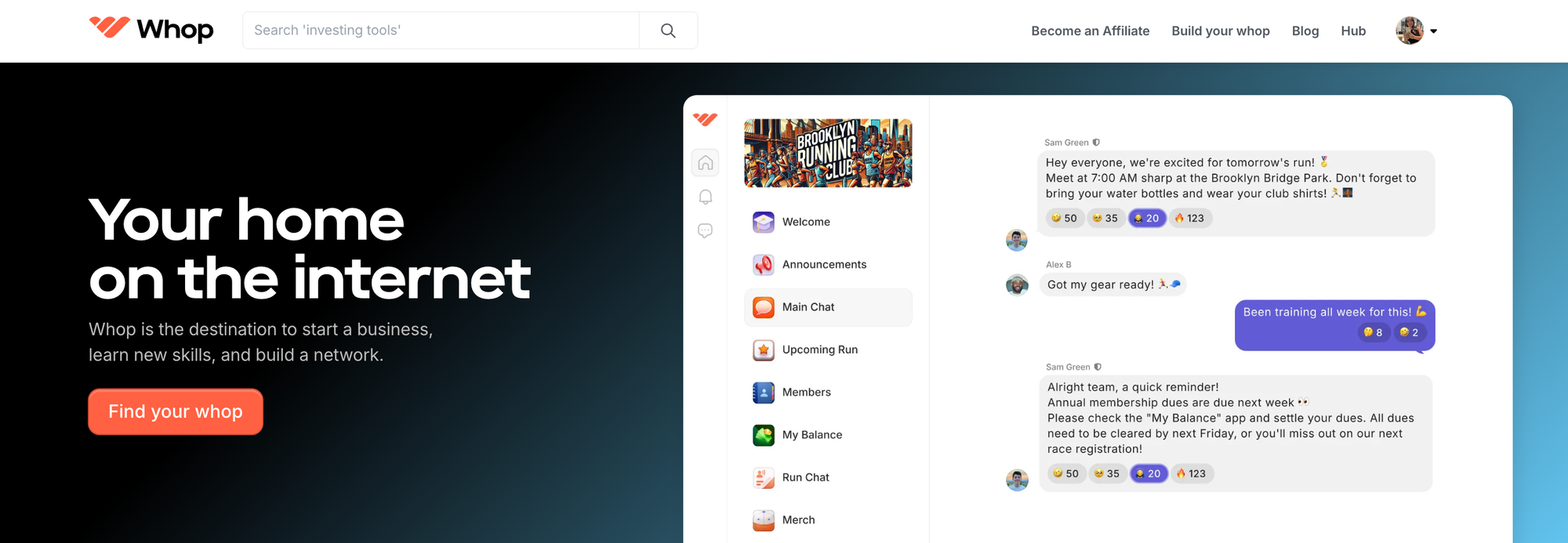
Best for: Everyone to make money online.
How the app works: Whop is a social commerce platform where everyone can make money the way they want, whenever they want. The way it works is that you can sell various digital products and services to people all across the globe.
You can sell things like:
- ebooks
- access to a paid community
- courses
- templates
- graphic design
- fitness and meal plans
- study materials
- SaaS
- sports betting picks
- trading advice
- one-on-one coaching
The above are just the tip of the iceberg, though. As long as you have an idea and a little bit of time, you can easily make it work with the help of Whop. The best part is that you can make an active income—meaning regularly adding more products and getting paid for each—or passive income, where your ebooks or courses will continue getting sold indefinitely while you're doing something else.
Once you set up your own whop, you can add products easily with pre-made apps—minimal setup and no programming required! Getting started only takes a few minutes.
How you get paid: Bank transfer through Stripe via ACH. You control how often you get paid; daily payments available.
What you need to use it: Android/iOS-based smartphone and a bank account.
Pros:
- You're in full control of your income—work whenever you want
- You can do anything you want, from selling courses to getting paid for coaching sessions with your clients
- Passive and active income
- No monthly fees
- User-friendly interface and quick sign-up process
- Whop Marketplace helps you get more sales
Cons:
- Whop takes a small cut out of each sale (3%) with an extra fee for marketplace sales
2. Uber
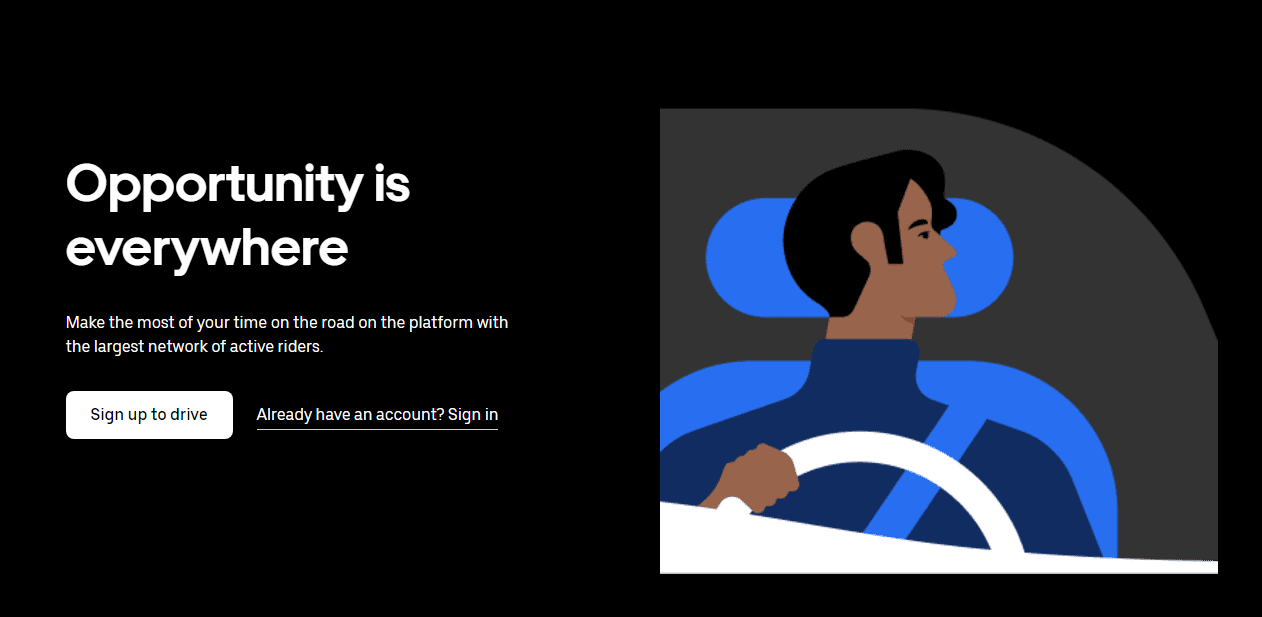
Best for: People who have a car and want to turn it into a side hustle opportunity.
How the app works: Most of us have used Uber and Uber Eats at some point in our lives, but you can also flip the script and turn from customer to driver. Each app covers a different sort of gig and comes with its own set of requirements.
If you sign up to become an Uber driver, you'll get requests directly through the app. Once you pick one, you'll pick up the passenger and drive them to their destination. How much you make depends on things like distance, time of day, and tips.
Uber Eats drivers don't need a car, although you can use one if you want; scooters and bikes are okay, too. Your job will be to pick up deliveries and then drive them to their destinations, and you'll be paid based on distance and tips.
It's worth noting that both Uber and Uber Eats run a background check when you start (and then periodically), so you can't start earning right away.
How you get paid: Weekly payments are the norm, although you can get paid instantly with Instant Pay at an extra fee. Uber takes a cut out of each ride and delivery, but there's no set figure for how much you lose. Many drivers claim that Uber takes between 15% and over 50% of the cut, but you keep 100% of all tips.
What you need to use it: For Uber, you need to be at the minimum age required to drive in your city, and new drivers are expected to be at least 25 years old to transport passengers. You need to have at least a year of licensed driving experience in the U.S. Unsurprisingly, you also need a valid in-state driver's license and a 4-door vehicle.
For Uber Eats, the requirements are more lenient: you need to be at least 19 for car and scooter deliveries and 18 for deliveries by foot or on a bike. You'll need a valid driver's license or a government ID depending on your vehicle, and proof of insurance.
Pros:
- Flexible schedule
- Daily payouts are available if you don't mind paying extra
- Certain times of day and locations can pay well if you're around for it
- You keep all the tips
- No experience required
Cons:
- Uber takes a significant cut of each ride or delivery
- The background check might take time
- Earnings vary from day to day
3. Cash Giraffe
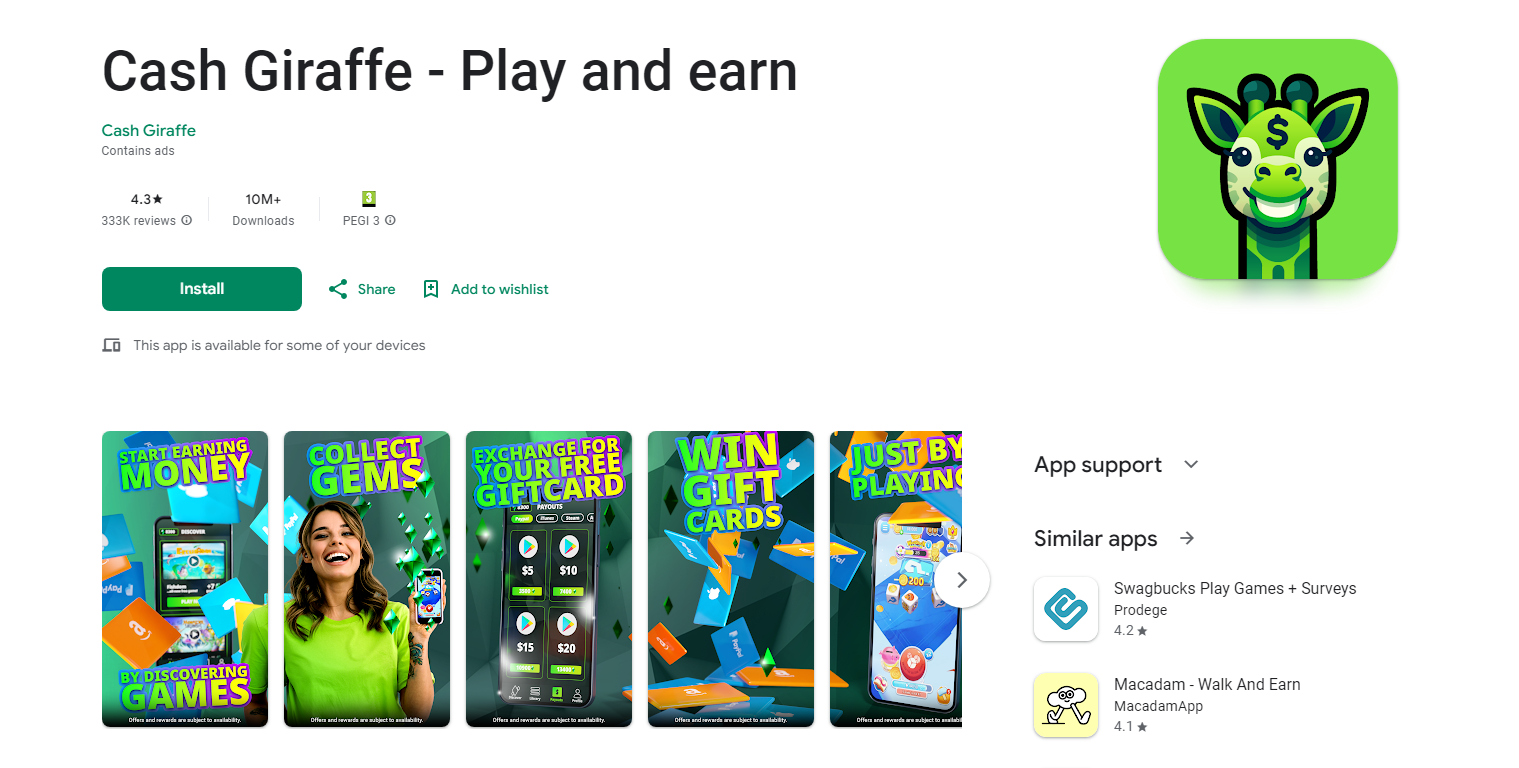
Best for: Android users who enjoy mobile games and want to make some extra money.
How the app works: Cash Giraffe lets you make money on your phone by playing games and completing surveys. The tasks are fairly repetitive, and the idea appears to be that you try as many games as possible, as the longer you play a game, the less you earn for it.
Once you complete a task, you get gems for it, and the app lets you cash out once you reach 2,000 gems (roughly $0.20). The downside of this app (and many similar apps) is that your earnings are bound to be small. If you get a few dollars a day, consider it a success.
On the other hand, you're getting paid for playing games—that's pretty cool, right?
How you get paid: Cash Giraffe processes payments through PayPal. If you use PayPal, the payment might take up to five business days to arrive; gift card codes should be quicker to reach you, and options include Amazon, Starbucks, and more.
What you need to use it: An Android-based smartphone; unavailable on iOS.
Pros:
- Get paid for playing games
- Free to use
- Low minimum cash-out threshold
- You can get money or gift cards
Cons:
- Very low earning potential
- Only available on Android
4. OfferUp
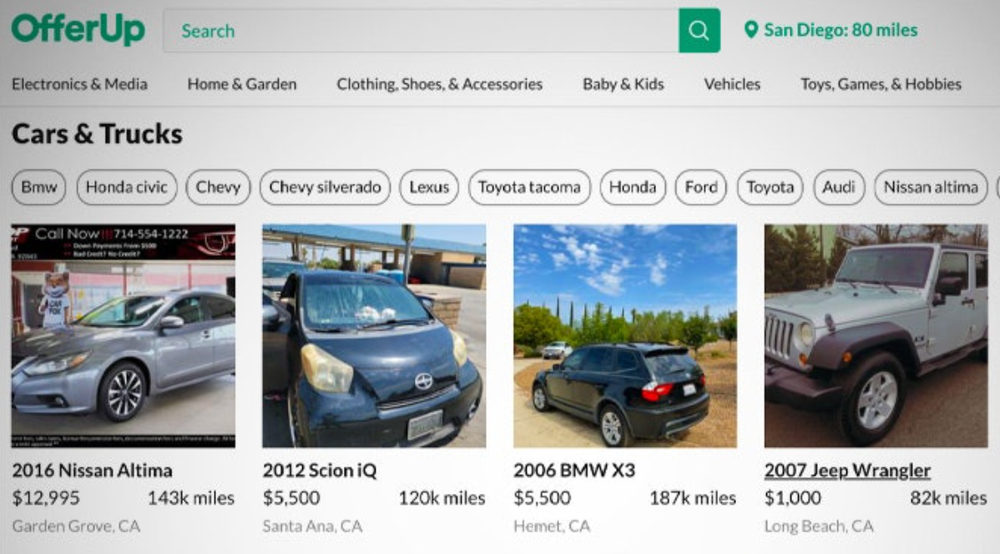
Best for: People who want to make money by selling locally.
How the app works: OfferUp is one of the most popular apps for selling things. I don't mean digital products—I mean actual, physical items, like that hoodie you've grown tired of or a pair of sneakers that don't quite fit. It's unique in that it mostly targets local sales where you'll meet up with the buyer in person most of the time, although nationwide shipping is an option too.
Use this app to get rid of things you have lying around. There's a surprising amount of money to be made just from stuff we don't really need; I made well over $300 just selling some old books not too long ago.
If you're feeling entrepreneurial, you can also use OfferUp to explore reselling for profit.
How you get paid: If you're selling in person, you get paid directly, either in cash or via apps like PayPal, CashApp, or Venmo. If you're shipping, the payments go through the OfferUp app. The payment only gets released to you when the item gets delivered and accepted by the buyer. At that point, you can choose a standard bank deposit, which takes up to five business days, or a fast deposit to your debit card.
What you need to use it: A smartphone with Android or iOS and a bank account (and something to sell!)
Pros:
- Easy way to make some money from things you already own
- No listing fees for local sales
- OfferUp has a built-in messaging system so you can talk to buyers on the platform
Cons:
- Huge 12.9% fee for items sold with shipping
- Having to meet up with strangers in person can be risky
- Only works in the United States
5. Upside
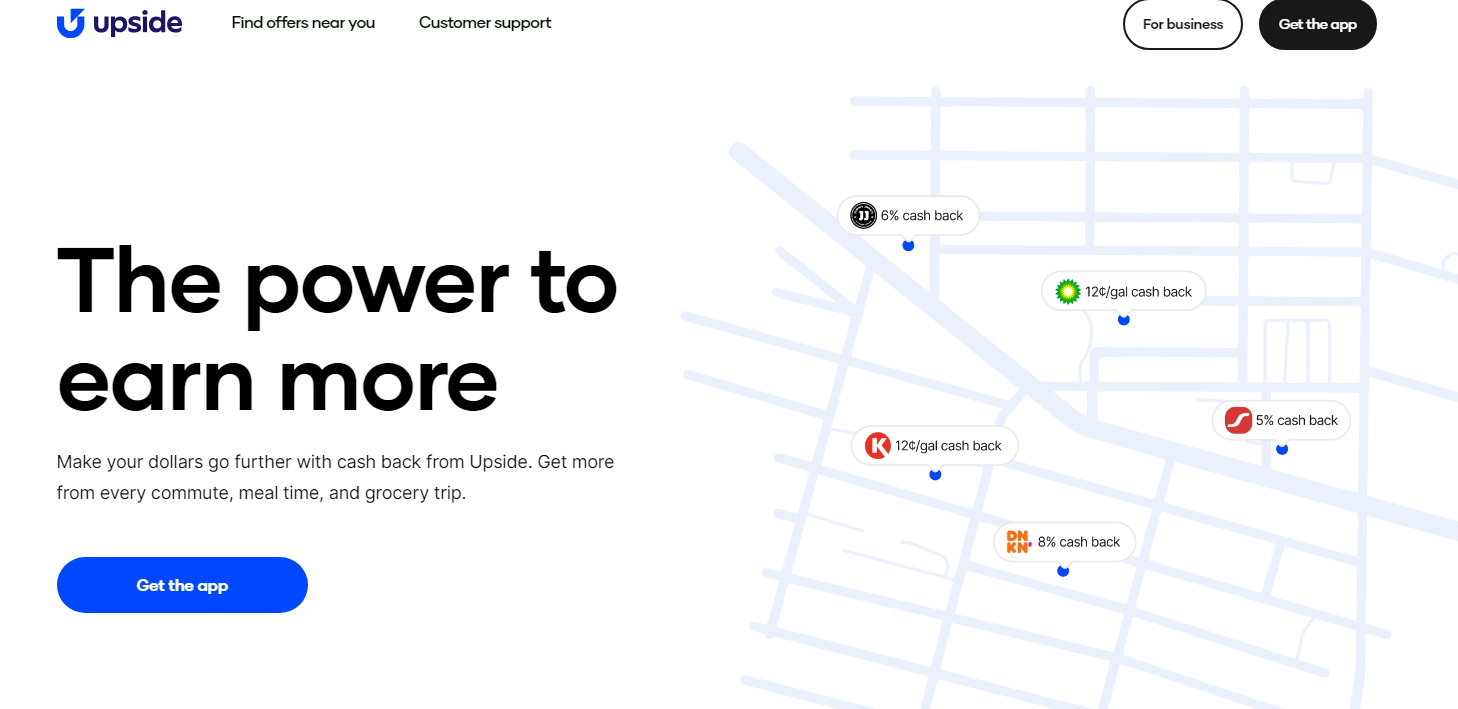
Best for: People who want to save some money on their shopping trips.
How the app works: If you've ever seen one cashback app, you've seen them all—but not all are great or legit. However, Upside is both.
With Upside, you can open the app and claim offers from nearby stores. This includes grocery shops but also gas stations and restaurants. Once you claim an offer, all you need to do is shop to your heart's content.
You get a percentage of your money back to your Upside account once you spend money on eligible offers. The exact amount varies based on the offer. You won't get much money through this, but if you can get paid for something you have to do anyway, then why not?
How you get paid: You can get paid through a bank transfer or PayPal. For PayPal, you'll have to collect at least $15 to avoid paying an extra transaction fee. Gift cards are an option, too. Upside usually processes payments within a few days.
What you need to use it: An iPhone or any Android phone; a valid debit or credit card.
Pros:
- Make some money while shopping
- No upfront costs
- Multiple ways to cash out
Cons:
- You have to spend money to make money
- You may be asked to upload receipts
- Cashback amounts usually aren't that high
6. Rewarded Play
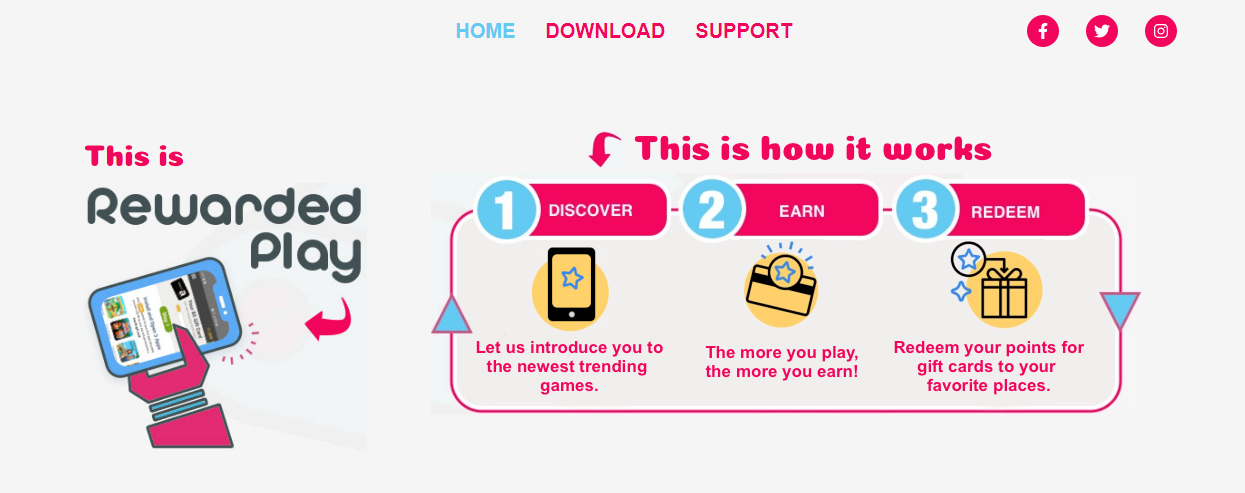
Best for: Casual gamers who want to earn gift cards.
How the app works: Rewarded Play is pretty much what it says on the tin: you get paid for playing games within the app. It's fun, but the earnings are modest and take a while to accumulate.
Playing games nets you points within the app, but you can't just leave it running and go get some lunch—you have to complete tasks or reach certain levels. Some tasks are as simple as playing for a certain amount of time. Some games require in-app purchases or watching ads, but you won't have to spend any actual cash to buy those in-game items.
How you get paid: You can cash out once you've earned enough points, and you'll need a lot of points for that: 45,000 points get you a $5 gift card, including options like Amazon, Walmart, or Target. It may take a few days for you to get your gift card.
What you need to use it: An Android phone (unavailable on iOS). You also need to be at least 18 years old.
Pros:
- Fun way to make some extra money
- Many gift cards to choose from
- It shouldn't take too long to get your first gift card
- No extra costs
Cons:
- You won't earn much with this app
- You can't get cash, only gift cards
- Unavailable on iPhones
7. Acorns
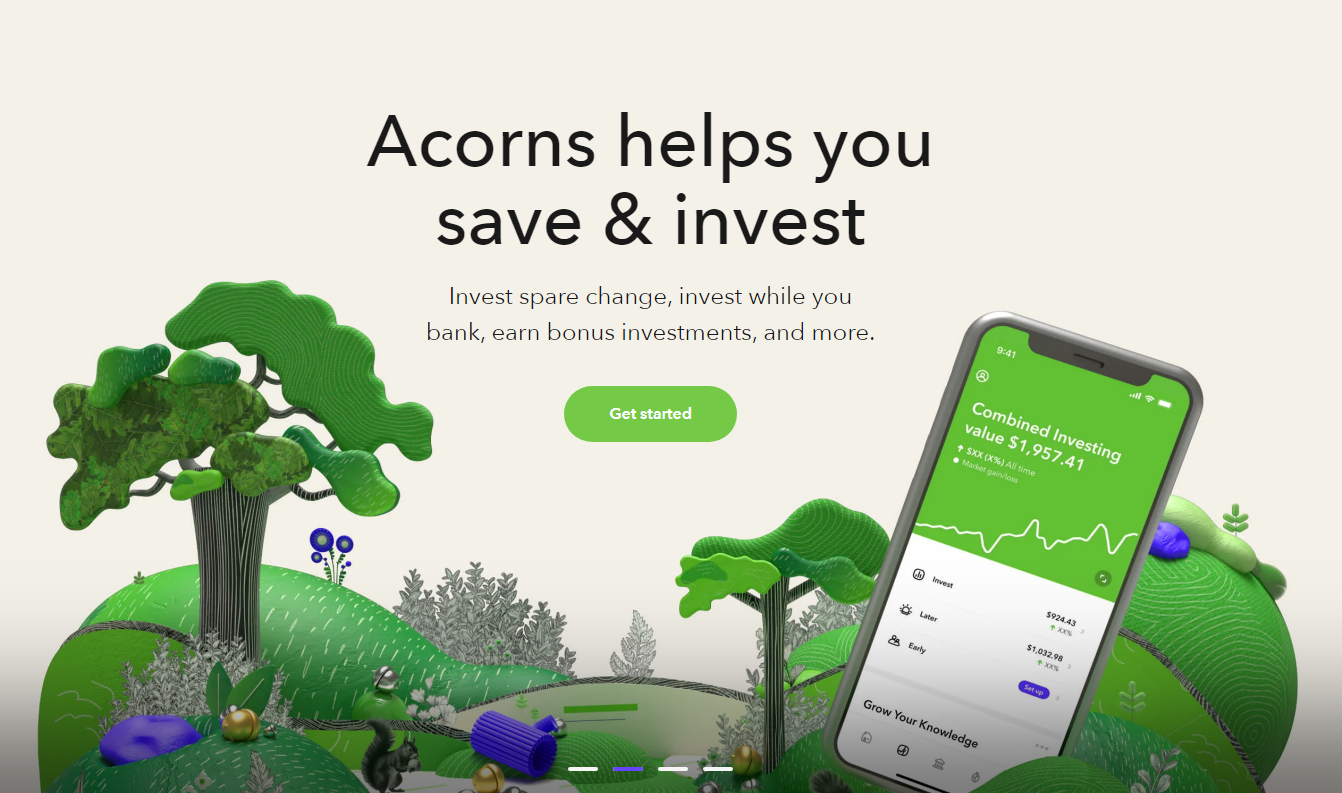
Best for: People who want to invest without an upfront capital.
How the app works: Acorns is a micro-investing app that can help you break into the world of investing in a very low-key way. Its perhaps most interesting feature is referred to as Round-Ups. This rounds up every eligible purchase that you make and invests the spare change for you.
There's also Acorns Earn, which lets you get a cashback of sorts when you shop with Acorns' partners—except instead of cash, you're getting more money toward your investment.
Acorns provides five different investment portfolios based on your risk tolerance, and each of those five portfolios is made up of ETFs.
There's one major downside of Acorns, though: it's not free. You'll have to pay a modest monthly subscription, ranging from $3 to $9 per month.
How you get paid: Building up money that's worth withdrawing takes a long time, and nothing is guaranteed. Like with any investment, the amount you make depends on how your ETFs perform. Once you're ready to cash out, Acorns supports bank transfers.
What you need to use it: A smartphone with either iOS or Android; a bank account; a minimum of $5 for your initial investment.
Pros:
- Beginner-friendly investing platform
- Low upfront capital
- The investments are automatic
- Cashback rewards
Cons:
- The monthly fees might take up the majority of your monthly ROI if you don't use Acorns much
- Some apps offer all of this for free but aren't as beginner-friendly, such as Robinhood
8. MobileXpression
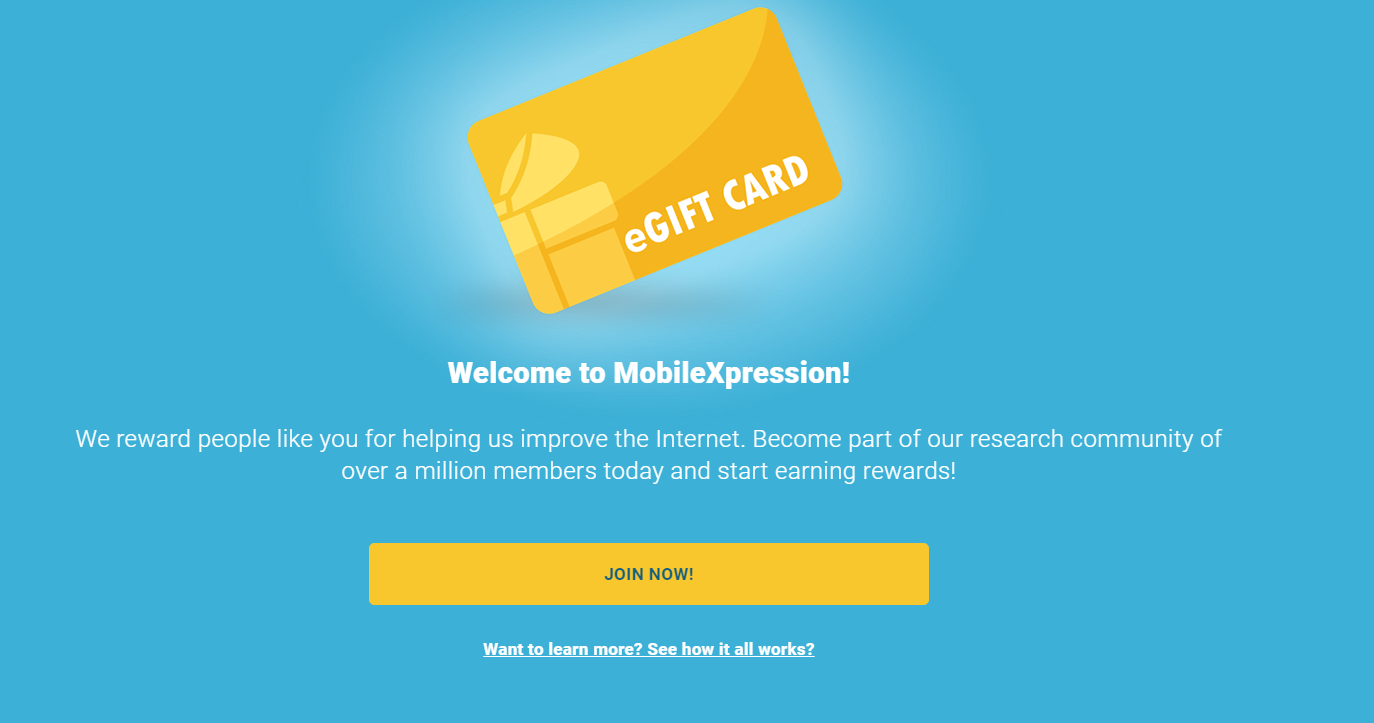
Best for: People who want to make a small passive income.
How the app works: Who would've thought you could make money online simply by sharing some data? Don't worry—it's not dodgy, at least not exactly. MobileXpression is a data collection app that keeps track of what you do on your phone and then uses that data for research purposes.
All of the data is anonymous, so you don't have to worry about your browser history getting leaked on the internet somewhere. Other than just letting the app run in the background while you do your own thing, you can also fill out surveys to earn more. The app also spices things up with the occasional sweepstakes, with prizes like iPads or straight-up cash.
How you get paid: Every week that the app is active on your phone gets you some credits. Once you've built up enough credits, you can trade them in for gift cards for retailers like Walmart or Amazon.
What you need to use it: A mobile device, either iOS or Android is fine; consistent internet access; need to be over 18 years old.
Pros:
- Super passive income—you don't have to do anything to earn money
- The first gift card is pretty quick to earn
- If you have multiple devices you can earn more
Cons:
- It's a little uncomfortable to share everything with an app, even if the data is anonymized
- You can't earn cash, only gift cards
9. Caden
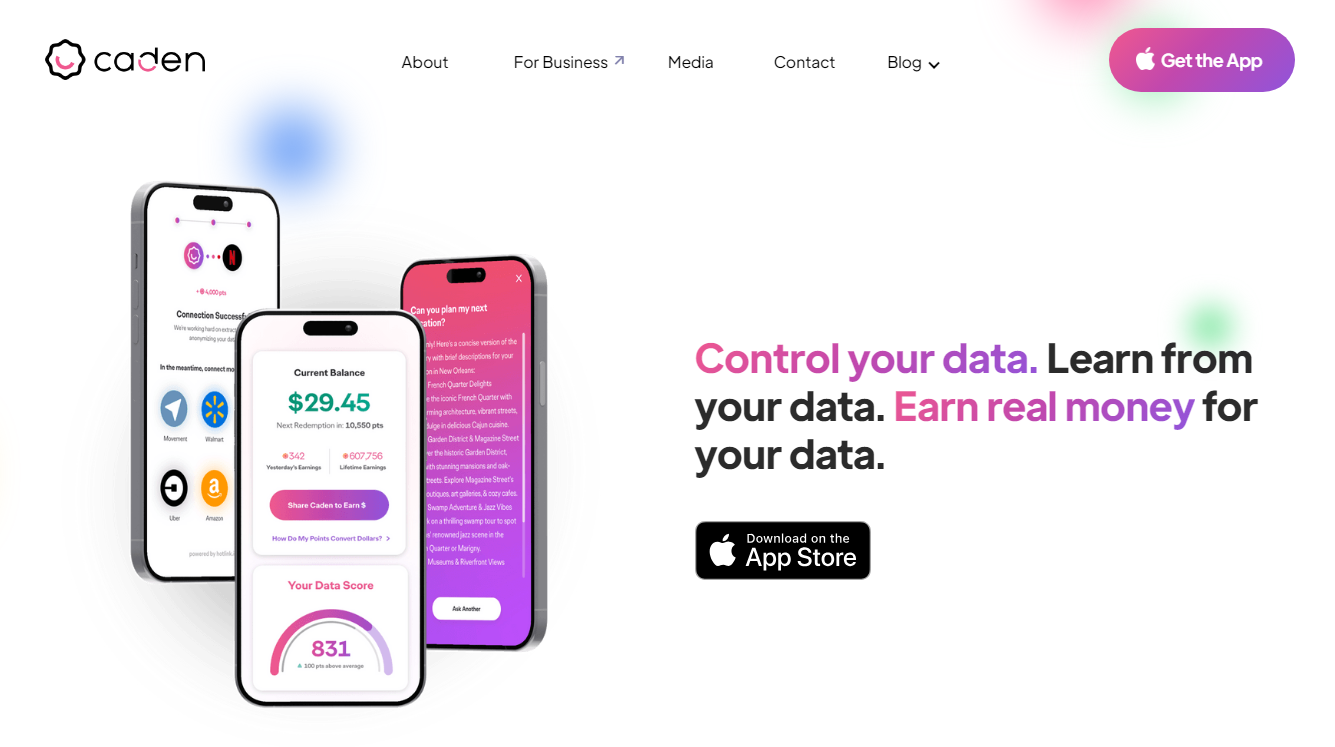
Best for: People with no privacy concerns who want to make a little money.
How the app works: Caden is similar to MobileXpression in that it lets you monetize your personal data to make some passive income. (There are much better ways to make a passive income, though, so check them out if this is up your alley.)
You can let the app connect to various accounts, such as Netflix, Uber, or Walmart. Once connected, Caden collects anonymous data on your usage. Companies can then request this data for research purposes.
You get a bonus for each account you connect, but after that, you just get a daily data dividend that depends on how many platforms you've linked with your Caden app.
How you get paid: Caden uses Stripe to process its payments, which means you'll need a bank account. You can't cash out until you reach 40,000 points, which is around $40.
What you need to use it: A device running iOS (unavailable on Android); a Stripe account; an internet connection.
Pros:
- You don't have to do anything to make money
- You get to control which data you're comfortable sharing
- You can get paid in cash instead of just gift cards
Cons:
- Unavailable on Android
- You'll make some money, but it'll be super slow
10. Decluttr
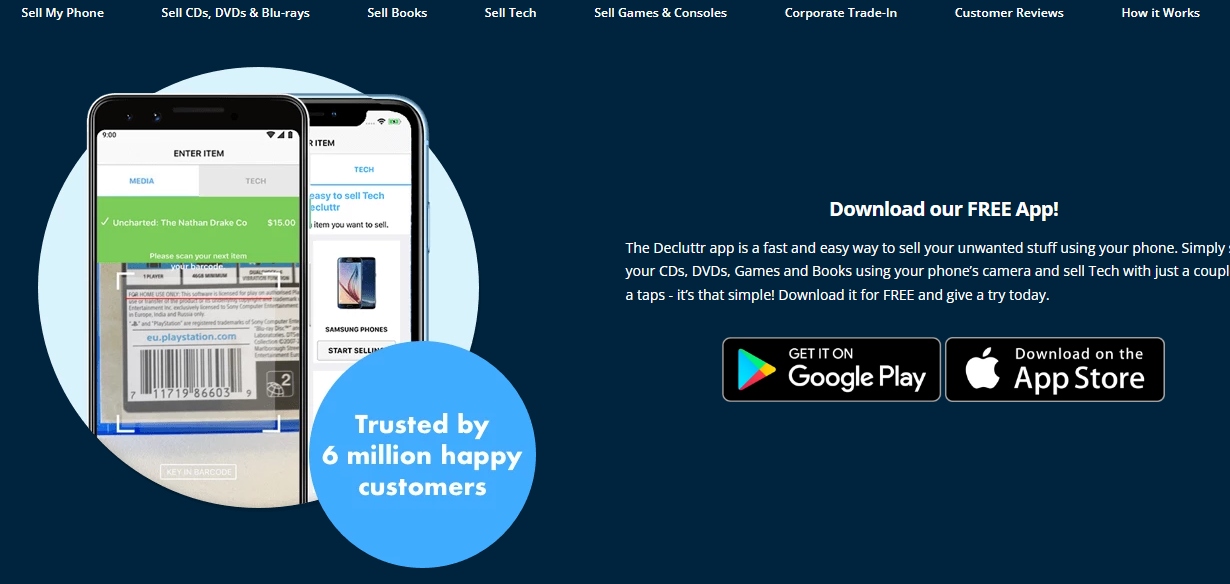
Best for: People who want to sell tech-related physical items.
How the app works: Decluttr helps you…well, declutter. It lets you sell CDs, DVDs, old phones, games, consoles, and other techy things easily.
You won't be selling to other people, though, which is how this app differs from competitors like OfferUp. Instead, you're selling directly to the company. You can scan barcodes or enter some crucial info about your electronics into the app and get an instant valuation. If you accept, Decluttr will send you a free shipping label and you're all done.
How you get paid: You only get paid if the item passes inspection once it reaches Decluttr. Payments can be made through direct bank deposit or PayPal soon after your item gets approved.
What you need to use it: A device with either iOS or Android.
Pros:
- No extra fees for selling
- Free shipping
- Safer than dealing with buyers by yourself
Cons:
- You could probably get more for your items by reselling them elsewhere
- You have to package and ship the item yourself
11. Arrived
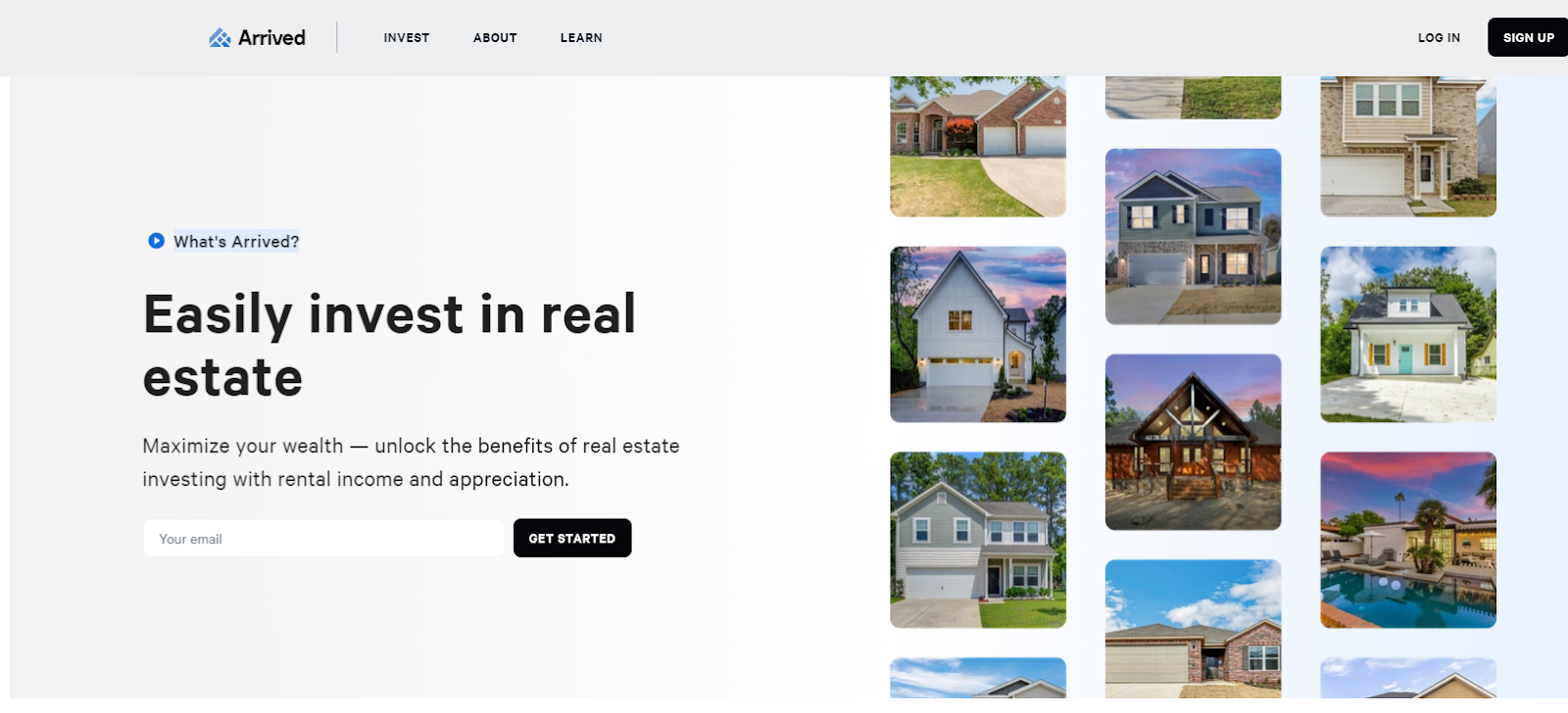
Best for: People looking to diversify their income.
How the app works: Investing in property is a solid plan, but how many people can afford to just buy a house at the drop of a hat? Fortunately, passive real estate investing exists, and investing in REITs can be a viable option. Arrived gives you a fairly hassle-free way to do this.
With Arrived, you'll start with an initial investment of $100 (or more) and pick a property or fund to invest in. This gives you a tiny bit of ownership in the rental homes that Arrived owns and manages. You'll then earn rental income passively, through monthly or quarterly dividends.
This is a long-term investment that you won't have to do anything with for years.
How you get paid: You can withdraw your monthly/quarterly dividends into your bank account as soon as you get them. You can also reinvest them in other properties if you prefer.
What you need to use it: An iPhone or another iOS device; at least $100 for your initial investment.
Pros:
- As far as rental investments go, $100 is a small starting capital
- Completely passive income
- You don't need to manage the property or deal with tenants
- Non-accredited investors can still invest
Cons:
- You'll probably need to hold your investments for years
- Arrived charges fees
- There may be no properties available to invest in
12. Poshmark
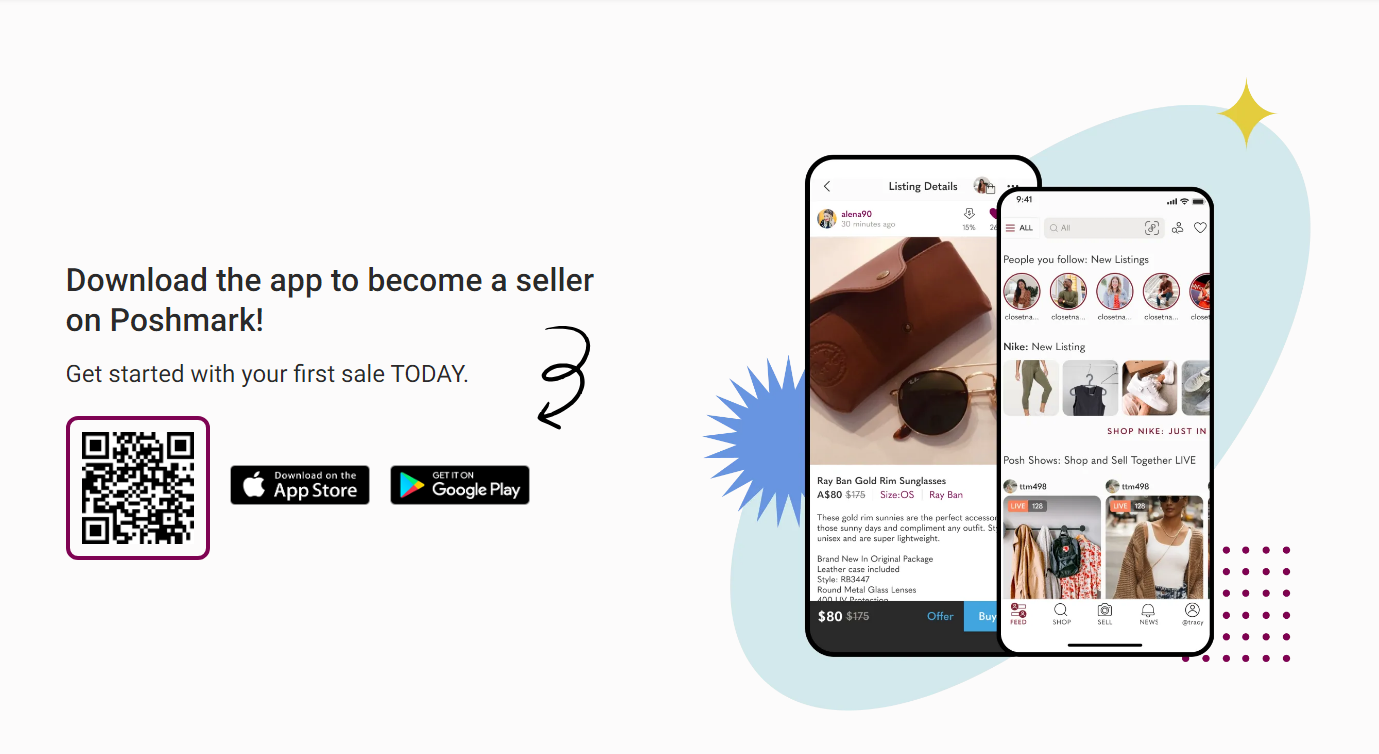
Best for: Anyone who wants to sell gently used items.
How the app works: Poshmark is considered the go-to app if you want to sell used (but in good condition!) clothes, shoes, accessories, electronics, home decor, or beauty products. This is the app you should turn to if you're going all Marie Kondo on your closet and you have a lot of stuff that you want to get rid of.
To start selling, you have to make an account, snap some pictures of the things you want to sell, and list them. Once you find a buyer, Poshmark will send you a shipping label so that you can pack up the item and ship it.
Even if you don't have any clutter around the house, you can still use Poshmark to work as a reseller. Check out our top 10 tips to become a successful reseller.
How you get paid: All the payments go through Poshmark, making it a secure affair. Once the buyer confirms that they received your shipment, you'll get paid. Poshmark takes a cut out of each sale, though.
What you need to use it: A smartphone with iOS or Android.
Pros:
- Prepaid shipping labels
- Secure payments directly through Poshmark
- The platform is recognized, so your items should be sold
Cons:
- Poshmark's cuts are huge: you'll pay a $2.95 commission for sales under $15 and a whopping 20% for each sale above $15
- You have to provide your own shipping boxes
13. Pogo
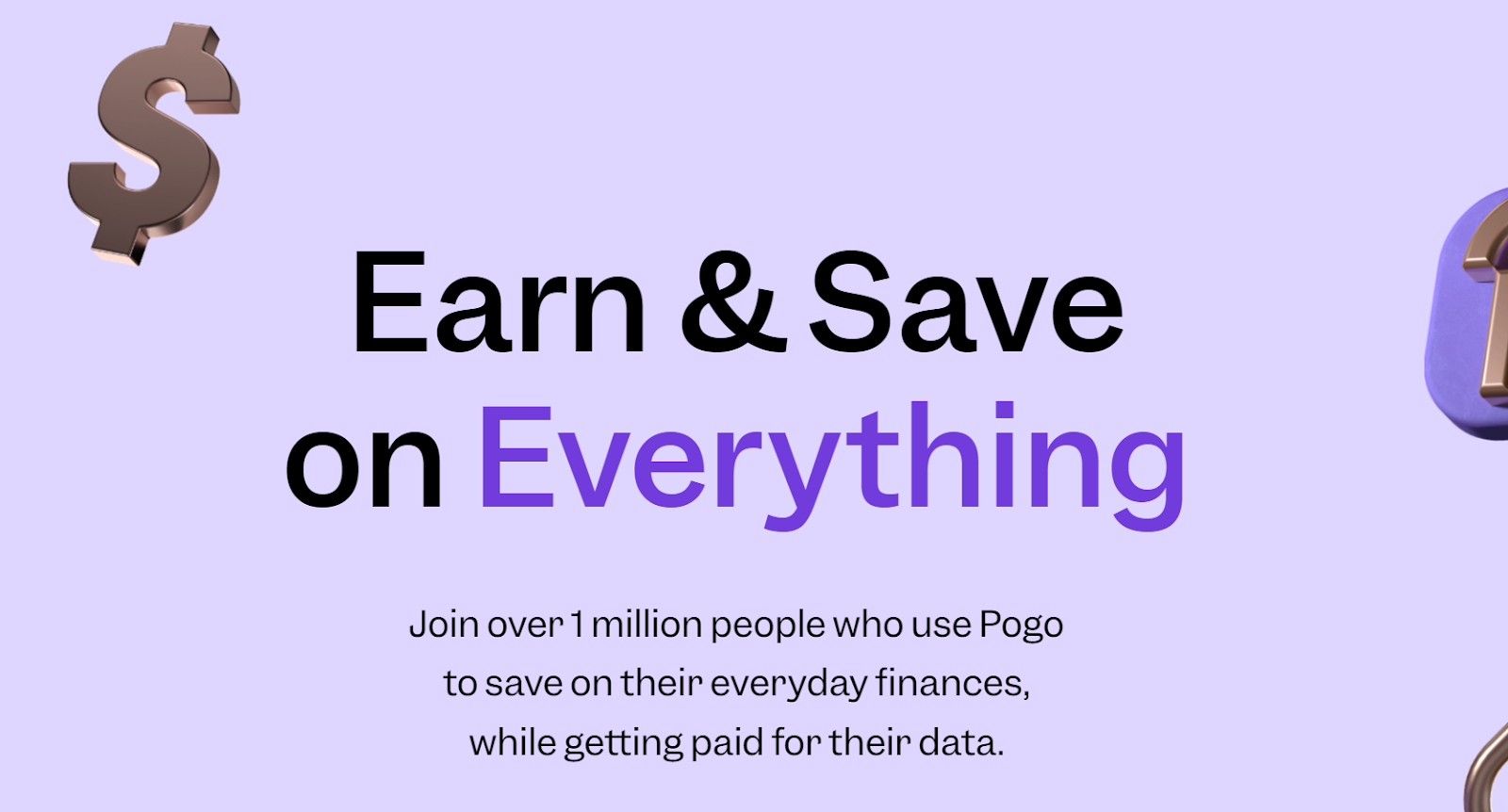
Best for: People who want some passive income and don't mind sharing their personal information.
How the app works: Pogo is something between a cashback app and a data-sharing app. You can share your transaction data, email receipts, and location history in exchange for rewards. To do this, you have to link your bank accounts and credit cards to let Pogo track your spending.
Pogo makes money by selling that data for market research purposes but also through personalized offers and ads. It's all anonymized, though.
How you get paid: You need to save 3,000 points before you can cash out through PayPal or Venmo.
What you need to use it: A smartphone running iOS or Android; a bank account or card that's been linked through Pogo's partner, Plaid.
Pros:
- True passive income—you don't have to do anything once you set it up
- You can request a payout at just 3,000 points ($3)
Cons:
- Sharing financial data is always a little unnerving
- You won't make a lot of money doing this
14. Survey Junkie
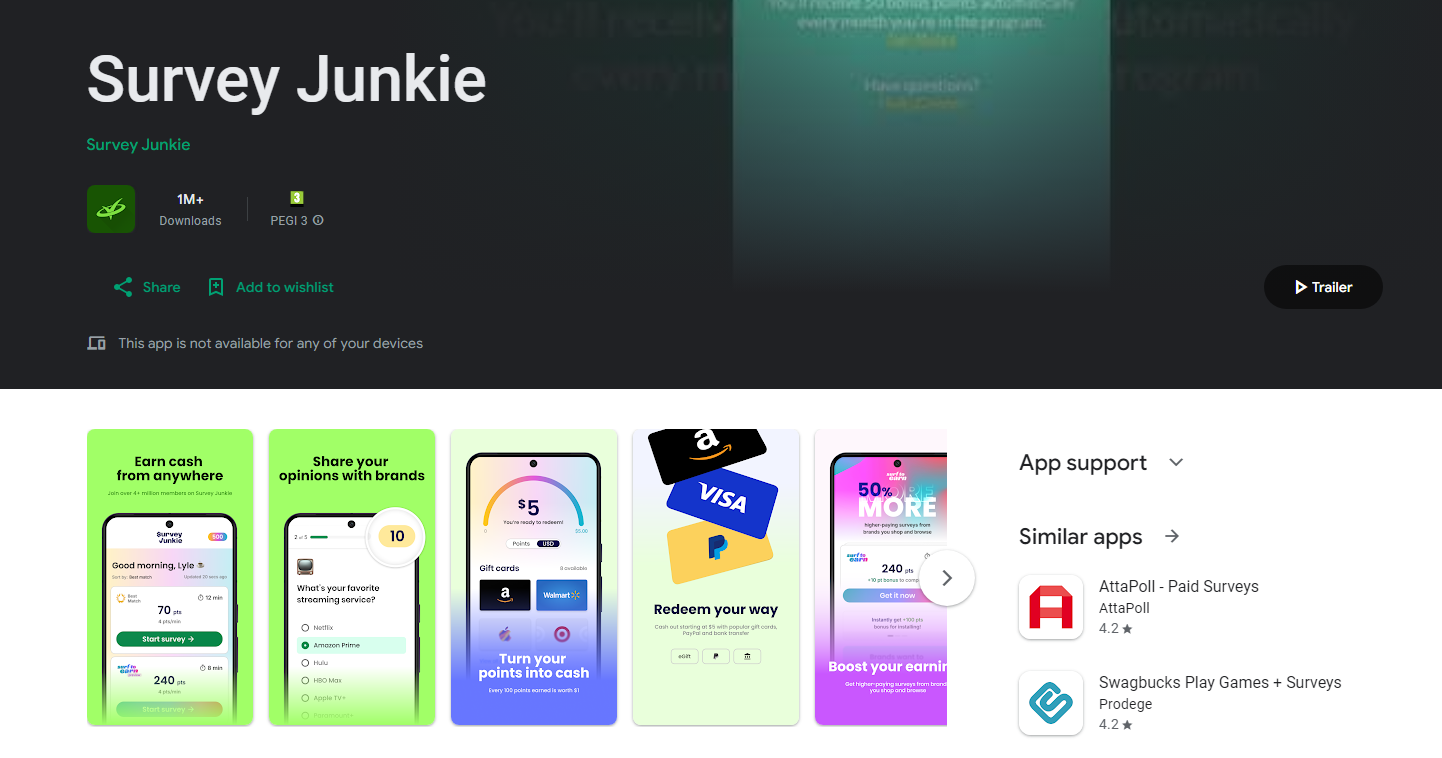
Best for: People who want to make a little money by taking surveys.
How the app works: Survey Junkie does exactly what you'd expect: it lets you take surveys and pays you for them. You'll start by filling out your profile, which helps the app find relevant surveys for your demographics. Some of the surveys are quick, but some can take up to 30 minutes.
Every survey nets you some points. Survey Junkie also has a subsection called SJ Pulse, and this is essentially a copycat of apps like MobileXpression. It tracks your online activity and gives you some points in return.
How you get paid: Once you've saved up at least 500 points ($5), you can either redeem your money through PayPal or a bank transfer. Many gift cards are also available.
What you need to use it: A phone with iOS or Android. Survey Junkie is not available in every country, and you need to be at least 13 or 16 years old to participate (depending on where you live).
Pros:
- Even teens can earn money
- You can choose cash or gift cards
- You only need to earn $5 to cash out
Cons:
- You may be disqualified mid-survey
- The earnings are very small
15. Rover
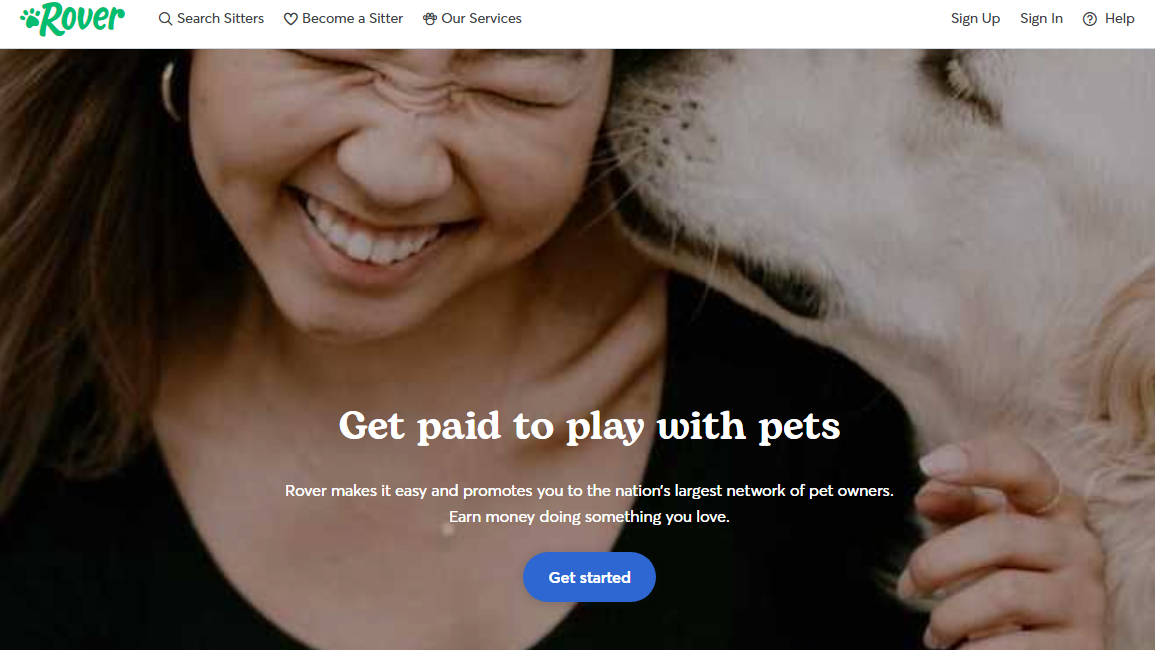
Best for: Animal lovers who want to make extra money.
How the app works: Who doesn't want to get paid for hanging out with a cute kitty or a fluffy pup? Well, everyone who's ever worked as a petsitter or dogwalker knows that it's not quite that easy, but Rover is still a good way to make money while doing what you love (read: spending time with animals).
Working through Rover is a flexible gig where you are connected with pet owners who need services such as dog walking, boarding, or pet sitting. People will book your services based on your profile. Once you accept a booking, you take care of their pet and get paid through the app.
How you get paid: Rover pays via direct deposit within 48 hours after you complete a gig.
What you need to use it: Smartphone with iOS or Android. Rover runs background checks and requires government ID.
Pros:
- All kinds of pet-related jobs, from dog walking to boarding
- Rover takes care of disputes and gives you a secure platform to talk to customers
- You set your own hours
Cons:
- Getting approved takes a while (up to 20 business days)
- Gigs won't always be available
- Rover charges a hefty commission of up to 25%
16. TaskRabbit
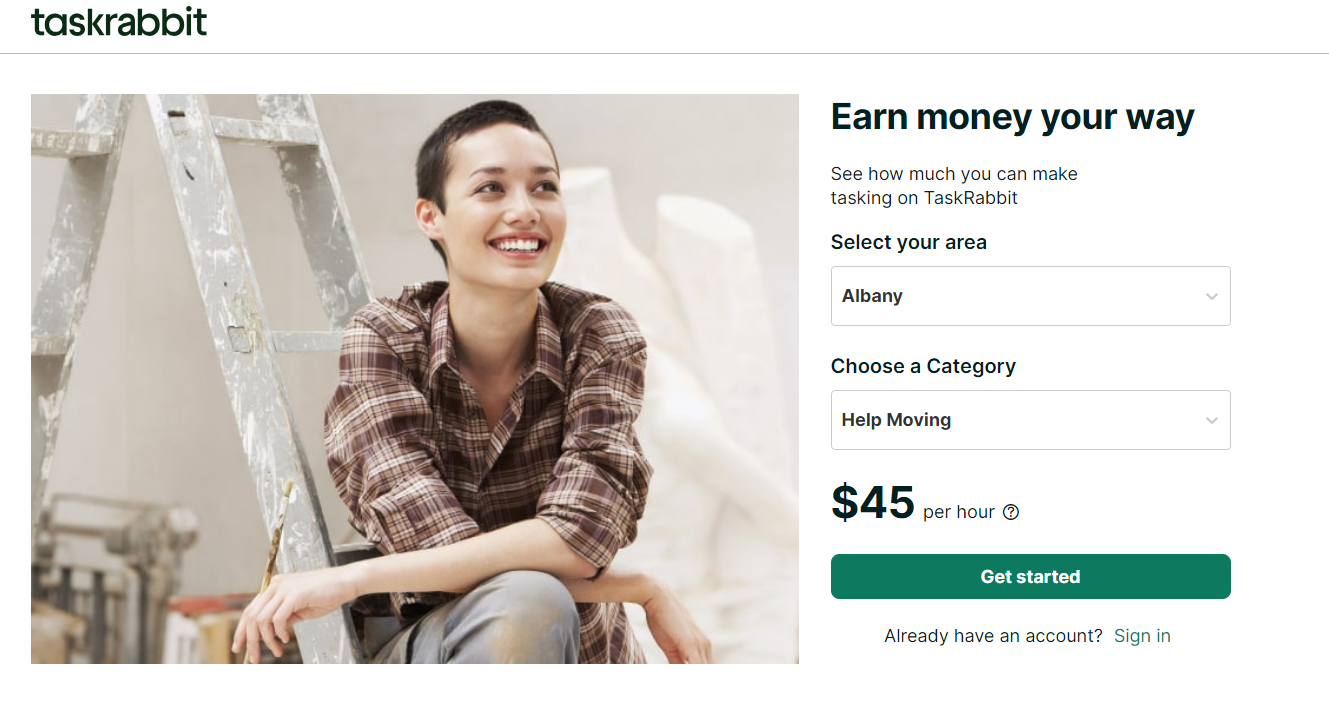
Best for: People who want to get paid for doing a physical job.
How the app works: Let's be real: many people have more fun sitting on the couch than doing whatever needs to be done around the house. (It's me, I am "many people.") If you're willing to do it for them, there's good money to be earned. This is where TaskRabbit comes in.
On TaskRabbit, you can offer services such as putting furniture together, moving help, cleaning, and various handyman tasks. It's all flexible, so you can set your own hours and choose to decline or accept the tasks that you get matched with.
How you get paid: Once the service is complete, you should get paid within 48 hours.
What you need to use it: Your iOS or Android-based smartphone; valid ID; often your own tools. You may also need to pass a background check.
Pros:
- You can take on all kinds of gigs, keeping it fresh
- Flexible hours
- Quick payouts
Cons:
- Not every location is brimming with tasks to pick up
- TaskRabbit takes a hefty 15% cut of every payment
17. Swagbucks
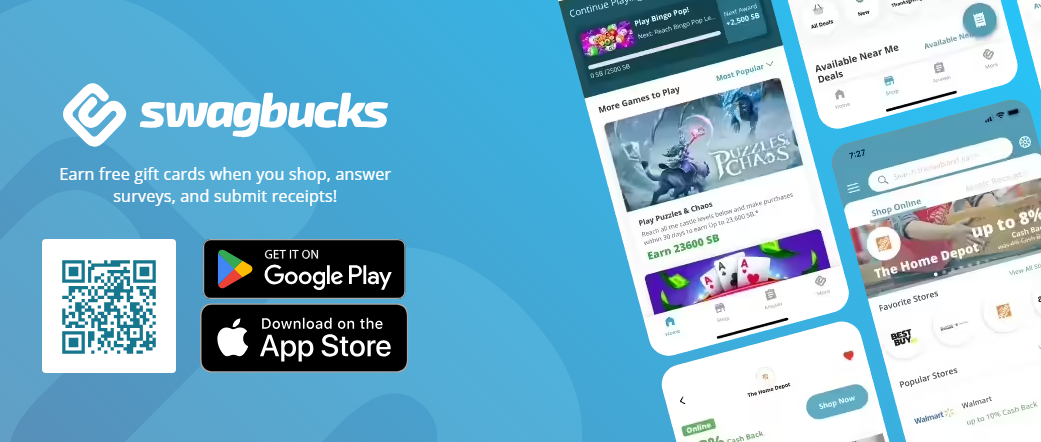
Best for: People who want to earn a little bit of money on the side.
How the app works: As far as money-making apps go, Swagbucks is up there in terms of popularity. It might be because the tasks listed on the app are pretty varied, including watching videos, playing games, filling out surveys, or shopping online.
All of the above tasks give you a small amount of SB points. Those points can then be redeemed for gift cards or money. It really is that simple.
How you get paid: Once you reach the minimum threshold of $1, you can cash out for a gift card. The minimum to get paid through PayPal is $5.
What you need to use it: You need to be at least 13 years old and provide parental consent if you're a minor. You also need a smartphone with iOS or Android.
Pros:
- The tasks tend to be super simple
- You can get a gift card quickly, with $1 options available
- Choose between gift cards and cash rewards
Cons:
- You need to complete many tasks to make any money
18. Ibotta
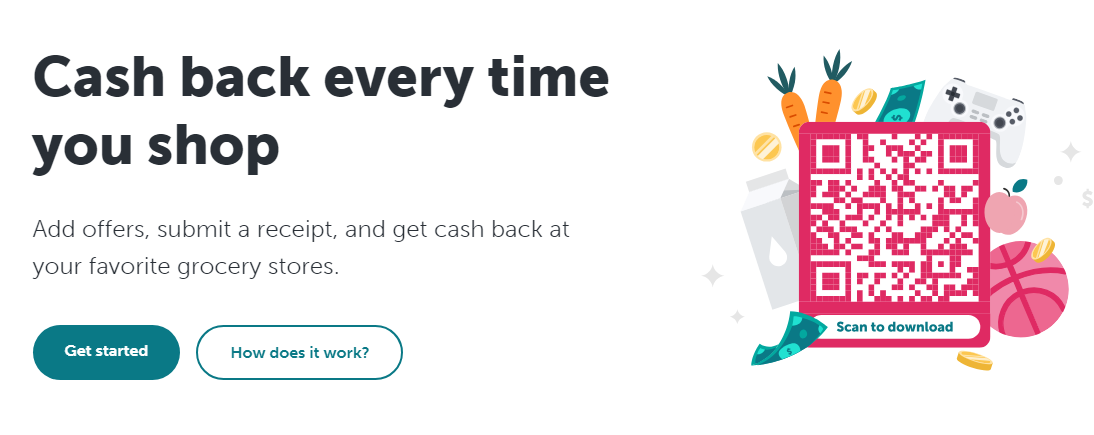
Best for: People who want to get some cashback on their daily shopping.
How the app works: Ibotta is yet another cashback app. The good thing about these is that you don't need to be loyal to just one app—maximizing your income means downloading several and using the ones that pay you something for your particular shopping trip. In the case of Ibotta, that'll be trips to the grocery store, but also shopping at online and brick-and-mortar retailers of all kinds.
Using Ibotta is straightforward. Browse the offers that interest you, pick the one you want, and then go ahead and shop. Connect your account to let Ibotta automatically keep tabs on your purchases or upload a receipt to get some of your cash back.
How you get paid: You need to reach $20 before you can withdraw your earnings, at which point you can do so through PayPal, bank transfer, or gift cards.
What you need to use it: An Android or iOS smartphone. And don't forget your receipts!
Pros:
- Cashback from online and in-person shopping
- The app is free to use
Cons:
- Getting to $20 might take a while
- Some locations don't have many interesting offers
19. CashWalk
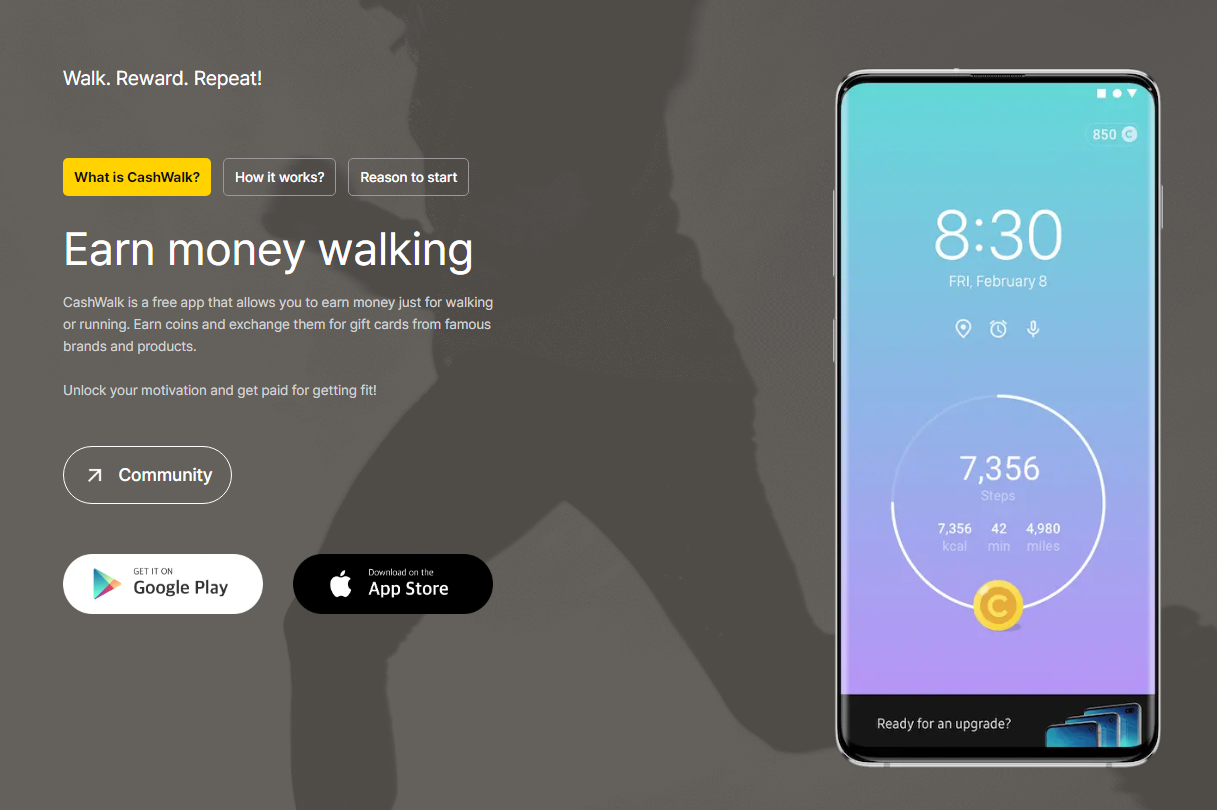
Best for: People who are (or want to be) active.
How the app works: Whether you're on your feet all day long or you want to be more active, you could be getting paid for it through CashWalk. This is a free app that counts your steps and gives you rewards for walking and running, be it on a treadmill or outdoors.
Every 100 steps you take turn into Stepcoins. You can get gift cards for these Stepcoins, and if you're walking, that's all you need to do. CashWalk also has more ways to earn coins quicker, though, such as watching ads or completing challenges.
How you get paid: You can get gift cards for popular retailers once you hit certain thresholds. You need 5,000 Stepcoins for a $5 gift card, which is a whopping 500,000 steps.
What you need to use it: A smartphone with iOS or Android.
Pros:
- Great for people who walk a lot
- The app tracks your steps and motivates you to walk more
- You can earn more if you complete challenges or watch videos
Cons:
- Walking enough to get even a small gift card takes a long time
- No cash payouts
20. italki

Best for: People who want to teach languages.
How the app works: If you know a language and you're willing to teach it, you could get yourself a pretty sweet gig with italki. The app lets you teach people from all around the globe.
There are two options: you can either be a Professional Teacher (requires certification and/or experience) or a Community Tutor (focuses on language practice and conversation; doesn't need any qualifications).
When you get started, you'll set your own hourly rates and availability. Lessons typically take place in the italki Classroom or through video-chatting platforms like Zoom.
How you get paid: You get paid with italki Credits at a ratio of 1 Credit to $1. You can withdraw via Payoneer, PayPal, or bank transfer as long as you have at least $30 in italki Credits.
What you need to use it: Language proficiency (in a language that italki needs), a smartphone with iOS and Android, and the required certifications if you want to be a Professional Teacher.
Pros:
- You can work whenever you want
- Getting started is free
- You can teach languages even without a background in teaching
Cons:
- There are often more teachers than students
- italki charges a 15% commission for your earnings
21. Fundrise
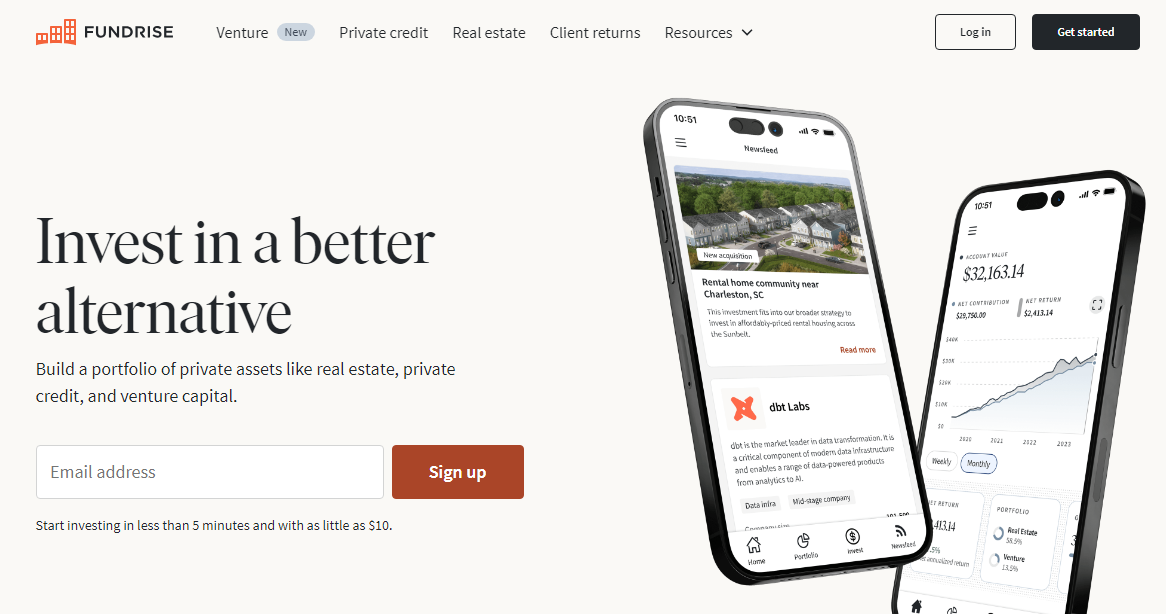
Best for: People who are interested in long-term investments.
How the app works: Fundrise and other apps like it are the epitome of money-making apps, because the whole point is that you're investing and hoping for a good ROI. Fundrise lets individual investors like you put some money into REITs (real estate investment trusts) and eFunds.
When you sign up, you'll choose an investment plan strategy.
How you get paid: Returns are paid out in the form of quarterly dividends. This is a long-term investment scheme, though, so you may be penalized if you liquidate and withdraw before the first five years have passed.
What you need to use it: A minimum investment ($10 for a taxable account and $1,000 for an IRA); a smartphone with iOS or Android.
Pros:
- Small initial investment
- You may benefit from property appreciation down the line
- You don't need to be accredited to invest
Cons:
- You should invest for at least five years
- You may be penalized for liquidating too soon
- Fundrise charges an extra 0.15% advisory fee and a 0.85% management fee for REITs
Are Money-Making Apps Worth It?
So, are money-making apps worth the time? That depends on two things: your needs and the app itself.
All of the apps on our list are legit, so that's a good start. There are hundreds or even thousands of apps out there that will never pay you a dime or will never have any work for you to do—that's obviously a waste of time.
Getting the scams out of the way, it all comes down to what you need. If you want something simple to do for an extra $20 or $50 per month, there are a lot of options. But spending time on those apps will never net you more than pocket change, so those apps can be a waste of time if you want to make more money.
The good thing is that it's entirely possible to make the equivalent of a full-time salary (or more!) every month, using only your phone. It's all about choosing the right app that gives you the best active or passive income without being too time-consuming.
Once you figure out which app that is, it's certainly worth your time. Apps that let you make as little or as much as you like are pretty rare, though.
Make Money Online With Whop - All You Need is Your Phone and an Idea
Few platforms truly let you become your own boss. With survey and game apps, your income is controlled by the companies that assign these tasks—if they don't have any work, then neither do you. On the other hand, apps like DoorDash or Uber are great, but the work can be tiring.
With Whop, you're your own business owner in every sense of the word. You decide what you do, and there are plenty of things you could be doing that pay well, such as:
- selling ebooks
- creating courses
- offering one-on-one coaching sessions
- selling templates, fitness plans, or study guides
- hosting a paid community
- running live events and classes
- creating a mastermind
- selling and reselling all kinds of digital products
- offering SaaS
- and much, much more!
You don't have to worry about any sort of earnings cap on Whop. You can make as much as you want, with many Whop creators earning over $2,000 per month, and some of our top sellers earning as much as $250,000 or more monthly. On the other hand, if you don't need much, you can use Whop to supplement your income and pad your savings account by earning passive income with digital products that can be resold over and over again.
That's the whole point: it's all up to you. You decide how much you earn, what you do, and how often you do it, while Whop focuses on helping you achieve your goals.
Start earning money on your phone with Whop today!
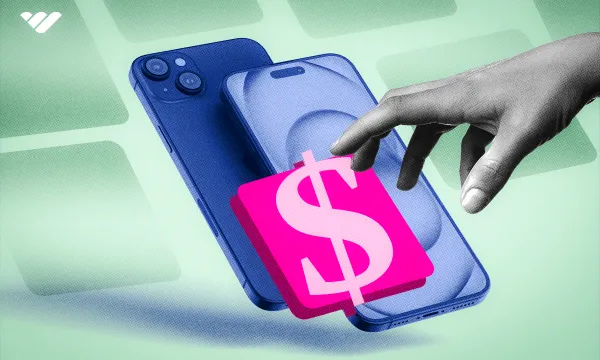
![40 Easy ways to make money online [2024]](/blog/content/images/size/w600/2023/11/20-ways-to-make-money-online--1-.webp)
